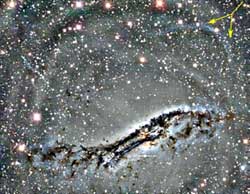Galaxy Merger Leaves Behind Telltale Blue Arc

Visible in the upper right corner of this image of the Centaurus A Galaxy is an arc of blue stars left behind when Centaurus A pulled in a smaller galaxy and tore it apart. Astronomers say the scar from this cosmic collision is fairly new and thousands of light years long. <br>Note: Image is available without arrows. Follow this link. <br>Photo by Eric Peng/JHU/NOAO
Astronomers have identified the vivid scar of a cosmic catastrophe: a blue arc thousands of light years long produced when a galaxy pulled in a smaller satellite galaxy and tore it apart.
The streak is composed of clusters of young blue stars that formed as the larger galaxy, Centaurus A, absorbed the smaller galaxy about 200 million to 400 million years ago. Researchers will report in the December Astronomical Journal that their discovery suggests absorption of smaller galaxies may be a significant contributor to the formation of galactic halos, outer perimeters of galaxies where star populations are sparse.
“This adds a nice example in the local universe to the growing evidence that galaxy halos are built up from the accretion of dwarf satellite galaxies,” said Eric Peng, a graduate student in astronomy in the Krieger School of Arts and Sciences at The Johns Hopkins University and lead author of the new paper. “These halos are interesting partly because they’re hard to study, but also because time scales for things to happen in halos are very long, which means they may preserve conditions that reveal how a galaxy formed and evolved.”
Peng and his colleagues found the streak in specially processed digital images of Centaurus A taken at the National Science Foundation’s Blanco 4-meter telescope at Cerro Tololo Inter-American Observatory near La Serena, Chile. The team made its observations in 2000.
At 10 million light years from our galaxy, Centaurus A (which is visible with binoculars in the southern hemisphere’s night sky, but not visible at all in the northern hemisphere) is quite close in galactic terms. The galaxy’s most prominent features include a central lane of dust and debris, and signs of violent activity on its perimeter that are suggestive of a prior galactic merger.
Astronomers had previously noticed the arc that Peng and colleagues have now identified as a galactic merger remnant, but without recognizing its origin. That took evidence Peng and colleagues gathered with Mosaic II, a new wide-field digital camera at the Blanco Telescope funded by the National Optical Astronomy Observatory.
Peng and fellow researchers Holland Ford, a professor of astronomy at Johns Hopkins; Ken Freeman, a professor at the Australian National University; and Rick White, astronomer at the Space Telescope Science Institute, used Mosaic II to create images of Centaurus A through several different color filters. Comparing these images highlighted regions of the galaxy that have different colors, and revealed the predominance of young blue stars in the arc. This allowed Peng and his colleagues to identify the arc as a remnant of a galactic merger and estimate the time when Centaurus A absorbed it.
Astronomers have identified similar remnants of galactic mergers in various stages of ingestion into the Milky Way, including the Sagittarius Galaxy. Peng said the newly identified remnant in Centaurus A is unusual in terms of both how recently the merger took place and how gas-rich the satellite galaxy appears to have been.
Ford noted that the group hadn’t originally set out to find remnants of dwarf galaxies.
“One of the joys of science is unexpected discoveries,” Ford said. “Although our pictures were taken for another project, we decided to search the data for evidence of ’shredded’ dwarf galaxies. We were very excited when the blue arc popped out of one of the images.”
Peng noted that the remnant cannot account for all the signs of prior galactic merger activity seen in Centaurus A. As an elliptical (or roughly football- shaped) galaxy, Centaurus A was likely produced by the merger of two large galaxies.
“It’s possible that the small galaxy that was recently accreted by Centaurus A was originally a satellite orbiting one of the large galaxies involved in that larger merger,” says Peng. “Just like when our galaxy merges with the Andromeda Galaxy in the distant future — the Milky Way’s satellite galaxies, such as the Magellanic Clouds, will likely be involved in that merger.”
Peng and other researchers are currently looking for other signs of remnants elsewhere in Centaurus A, and planning for follow-up observations on the arc they identified as a galactic remnant.
“If we can get the velocities of star clusters in the arc and map out the orbit, that will allow us to place better constraints on how long ago the merger occurred and on what the motions of the incoming galaxy were,” Peng says.
Media Contact
All latest news from the category: Physics and Astronomy
This area deals with the fundamental laws and building blocks of nature and how they interact, the properties and the behavior of matter, and research into space and time and their structures.
innovations-report provides in-depth reports and articles on subjects such as astrophysics, laser technologies, nuclear, quantum, particle and solid-state physics, nanotechnologies, planetary research and findings (Mars, Venus) and developments related to the Hubble Telescope.
Newest articles
Humans vs Machines—Who’s Better at Recognizing Speech?
Are humans or machines better at recognizing speech? A new study shows that in noisy conditions, current automatic speech recognition (ASR) systems achieve remarkable accuracy and sometimes even surpass human…

Not Lost in Translation: AI Increases Sign Language Recognition Accuracy
Additional data can help differentiate subtle gestures, hand positions, facial expressions The Complexity of Sign Languages Sign languages have been developed by nations around the world to fit the local…

Breaking the Ice: Glacier Melting Alters Arctic Fjord Ecosystems
The regions of the Arctic are particularly vulnerable to climate change. However, there is a lack of comprehensive scientific information about the environmental changes there. Researchers from the Helmholtz Center…



